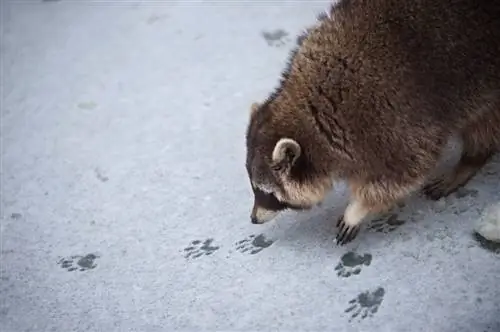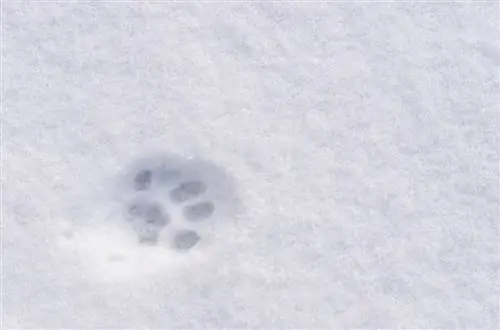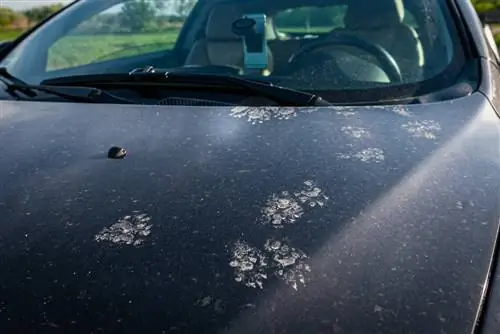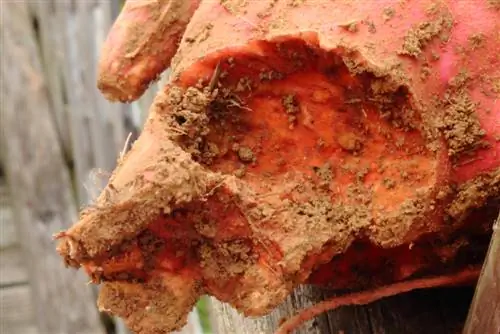- Author admin [email protected].
- Public 2023-12-16 16:46.
- Last modified 2025-06-01 06:02.
When children are given a worksheet with animal tracks in the snow, their interest in nature increases. Tracking is a skill that provides information about the hidden activities of animals. Winter is a particularly good time to identify animal tracks.
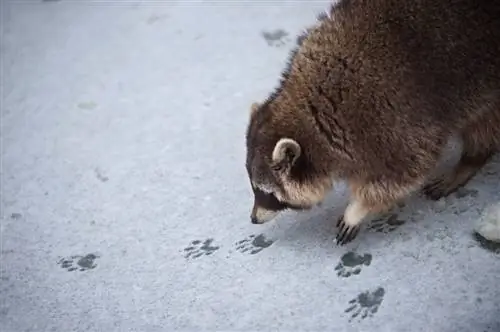
How do you recognize animal tracks in the snow?
Animal tracks in the snow can be recognized by the size and shape of the footprint as well as running tracks. Typical prints are of dogs, cats, rodents, rabbits and sometimes foxes. Distinguishing features are the presence of claw marks and the position of the toes in relation to the ball of the foot.
Identifying animal tracks in the snow
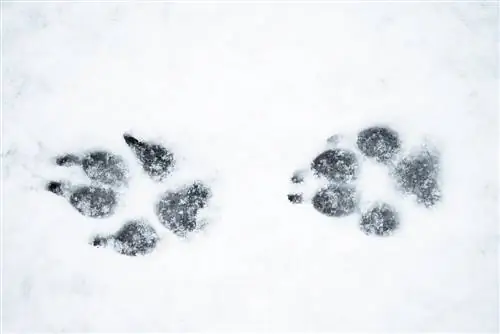
Dog tracks are quite distinctive due to the imprints of the two forward-pointing claws
Animal tracks in the snow tell a story. They create different images that are typical for each animal species and provide information about their living situation. In order to identify the cause of the so-called footfalls, an initial size classification helps. Reproducible scales (€9.00 at Amazon) are an important tool when you are looking for clues in the garden.

| Footprint up to 2 cm | Footprint up to 4 cm | Footprint up to 6 cm | Footprint up to 8 cm | Footprint up to 10 cm | |
|---|---|---|---|---|---|
| Marten | Weasel, stoat | polecat, stone marten | Badger, otter | - | - |
| Dogs | - | - | raccoon dog, red fox | Medium Dog | Wolf |
| Cats | - | Domestic cat | Wildcat | Lynx | - |
| Rodents | Mouse | Squirrel, Rat | Rabbit, beaver | - | - |
| Hoofed Animals | - | - | Deer, wild boar | - | Red Deer |
| More | Hedgehog | - | Raccoon | - | - |
Not all of these animals get lost in your garden. It is usually small mammals or rodents that leave their tracks in the snow. With a little practice you can match the prints. Don't just look at individual footprints but at the overall picture of the trail.

Marten
Traces of pine martens and stone martens are very similar. They consist of five toe pads, on which the claws are clearly visible, and reach a size of between three and five centimeters and a width of three to four centimeters. The prints are about the same size as the cats' footprints, where only four toe pads are visible.
Tips for distinguishing stone martens from pine martens:
- Pine martens have more hairy feet than stone martens
- The contours of the foot seal are indistinctly drawn due to hairiness
- Beech marten prints have clearly recognizable contours
Way to run
You can recognize different constellations when walking normally. When the marten jumps, the two front footprints are parallel on a line. The two hind legs leave an obliquely offset impression. The top view creates a triangle.
Fox
In the red fox's tracks, four toe pads and their claws can be seen next to the main pad. The front and back paws are about the same size. A single footprint can be confused with a small dog's footprint. Look at the balls of your toes. The fox's two inner toes are pushed forward so far that their rear edges are in line with the front edges of the outer toe pads. In dogs, the inner toes are not pushed as far forward. Cats leave smaller footprints that appear rounder and do not have claw marks.
How to distinguish between fox and dog tracks:
- Foxes leave more elongated and oval tracks that look rounded in the snow
- Foxes have a rounded main pad, which in dogs is more heart-shaped
- The space between the ball of the head and the ball of the toe is relatively large
- Fox tracks are 5 cm long and 4 to 4.5 cm wide
Track
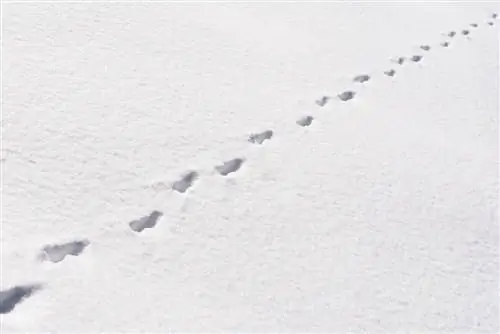
Fox tracks vary depending on how the fox runs
Red foxes have different gaits, so that the individual footsteps can be arranged differently in the snow depending on the situation. The constellation tells you a lot about the animals' lifestyle and whether they were on a foray or in a stressful situation:
- Trotting: Hind feet slightly offset in front of front feet
- Lacing: Hind paw steps into the imprint of the diagonal front paw
- Escape: different kick patterns with varying stride lengths
During the simple trot, the body position is oriented slightly obliquely to the direction of locomotion. The so-called lacing refers to the fast trot. With this gait, the footprints look like they are strung on a string. This straight track is created by placing the narrow feet behind each other in a line. The prints are evenly spaced about 30 centimeters apart.
Lacing is a slightly faster pace for the fox. Its footprints form an almost straight line similar to a string of pearls.
Rat
All long-tailed mice, which also include house rats and brown rats, have five toes on their hind feet. The middle toe is longer than the outer toes. There are usually four toes on the front paws. The fifth is often severely regressed and atrophied, resulting in the typical toe formula 4+/5. Brown rats have a weakly muscled tail that is dragged when they run. The grinding mark is clearly visible between the tread seals. In contrast, the very rare domestic rat lifts its tail when running.
Typical gait of a rat:
- Forefeet smaller than hindfeet
- Foot seals of the forefoot and rear foot on one side are offset one behind the other
- Track runs in a serpentine line
Raccoon
Raccoons have an excellent sense of touch, which is evident in their hand-like paw prints. In the wild, the new inhabitants pursue their favorite pastime and fumble in the shallow water on banks and streams to look for food. Therefore, the toes are comparatively elongated, so that the narrow prints look like fingers. In the foot seals, the toes are often spread apart and always connected to the ball of the metacarpal.
Tip
You can preserve foot seals with a plaster cast.
Attention, risk of confusion
Front paws are four to eight centimeters, slightly smaller than the hind paws, which are between five and ten centimeters in size. The untrained eye may confuse raccoon tracks with other footprints, but the hand-like shape provides a clear clue. How to distinguish raccoon tracks from animals with similar prints:
| Raccoon | Badger | Otter | Nutria | |
|---|---|---|---|---|
| Toes and Claws | long, finger-like toes with short claws | rounded to elongated toes with long claws | round toes with short claws | elongated toes with short claws |
| Heel of the metacarpal | indistinct and sole-like | clearly demarcated | sole-like | indistinct |
| Function of the paws | to eat | to dig | for swimming and digging | for digging and eating |
| Special features | Connect toes with the heel of the hand | Toes clearly separated from the ball of the middle | Tail drag marks and webbed feet visible | Tail grinding mark often visible |
Bunny
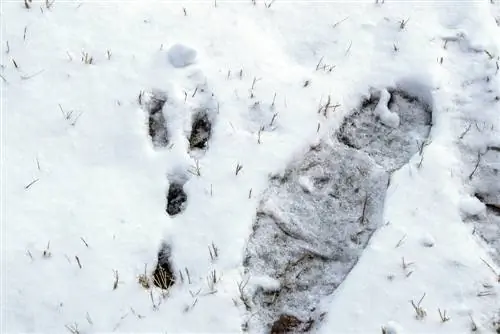
Hare tracks are relatively large
Hare tracks are very distinctive and can be observed in different habitats such as meadows, fields and forests. Rear paws of adult rabbits are longer than the front paws, whose footprint appears rounder. The front paw has five toes, of which the regressed thumb is not shown in the foot seal. The hind paw, on the other hand, is always four-toed.
Typical features of the tread seal:
- strong claws clearly visible
- Toe bunions are not present
- Paws covered with dense tufts of hair that look like toes in the print
Identifying a rabbit jump
Hares have two well-known gaits: hopping and fleeing. The hare's trail is also known in technical language as a hare's jump, in which all four paws can be seen as a typical jumping group. In this track, the longer prints of the hind paws are parallel to each other and in front of the footprints of the front paws, which are placed more or less clearly one behind the other. This pattern occurs because the hind legs rush over the front feet when hopping or galloping. If the hare is on the run, the hare jump can be up to three meters long.
Distinguishing features from similar prints:
- Squirrel: puts front and back paws next to each other, toes clearly visible
- Wild Rabbit: Footprints are significantly smaller, often with prints from many animals in the same place
Cat
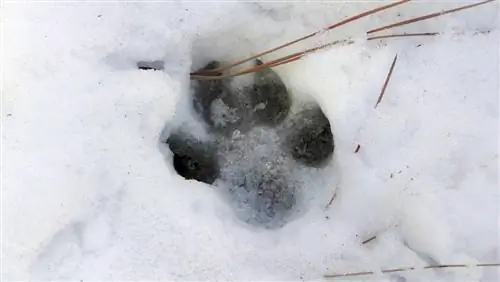
Four toes are clearly visible in cat tracks
Cats leave a footprint in which the four toes are clearly visible. The distance between the ball of the metatarsal and the ball of the toe is relatively large. Claws are usually not shown or are only shown indistinctly because the cat retracts its claws when moving. When jumping from a great height, the animal also leaves claw marks.
The prints are comparatively round and have sharply defined pads. The trail is partly similar to the trail of foxes, as cats move in a similar way. In contrast to dogs, domestic cats have asymmetrically arranged toe pads, one of which is significantly further forward.
Tip
In cats and dogs, the front paws are larger than the back paws. This is not the case with squirrels or rabbits.
Background
Why no claws can be seen in the tread seal
Cats are hide hunters and are not characterized by long endurance when running. Domestic cats are small cats that walk on toes. Their front paws have five toes, one of which has no contact with the ground and is therefore not visible in the print. Four toes are developed on the hind feet. The animals have sharp, curved claws. They are usually in the resting position and are pulled into a skin pocket by elastic bands. In certain situations these are extended:
- to catch and hold prey
- for climbing tree trunks
- to mark the territory with scratch marks
- for defense
Badger
This animal has powerful digging paws with a wide metatarsal pad that looks almost kidney-shaped. The five toe pads lie above the metatarsal pad and form a slight arch. This makes the footprint appear comparatively wide, which allows you to distinguish it from the footprints of dogs and foxes. The traces of the claws are clearly visible. When running, the toes are turned slightly inwards. However, you will hardly come across badger tracks in winter as the animals hibernate.
Typical running marks:
- Gait: uneven steps with stride lengths between 25 and 50 cm
- Trotting: Front feet almost parallel, hind feet offset diagonally; Step lengths between 70 and 80 cm
- Gallop: landing evenly so that the prints form a zigzag line
Frequently asked questions
I don't know whether animal tracks in the snow are from martens. Can I make the prints clearer?
To make it easier to recognize the tracks, you can sprinkle some flour or fine sand on the ground. However, the five toe pads are not always clearly visible. Pay attention to the arrangement of the toes around the main ball. In martens this appears comma-shaped.
Is there a trick to distinguish fox tracks from dog tracks?
The arrangement of the bales provides a good distinguishing feature. Do the cross test to find out who caused the dog-like tracks. Mentally draw two lines that lie crosswise on top of each other. They each pass through the spaces between the outer and inner toe balls and intersect directly above the main ball of the toe. The bales are not cut by the lines. When kicking a dog, you can't draw lines through the spaces without cutting the pads.
What do the terms track, track and footstep mean?
In hunters' language, footprints are particularly those of hoofed game. In common usage, the seal also means footprints of other animals. Several hoofed game footprints in a row form a trail. In other animals, the sequence of prints is called a track. For birds, the trail is called track.
How can I secure animal tracks in the snow?
Snow tracks can be preserved with plaster. To do this, press a piece of cardboard around the impression so that it is completely enclosed. Mix modeling plaster and pour the mixture into the box to a height of about two centimeters. Wait about 20 minutes for the plaster to dry slightly. It doesn't have to be completely hardened yet. Carefully dig up the cast and allow the plaster to harden. You can remove the cardboard edge using an old toothbrush.
What do brown bear tracks look like in the snow?
The predatory mammals are sole walkers, walking with the entire foot from the toes to the heel. The heel pad is almost always missing from the front paw. The rear footprint of an adult brown bear can only be confused with a somewhat blurred human footprint. Young bears leave footprints that are slightly larger than badgers' footprints.
The five pads of her toes are clearly visible in the print and the claws can also be clearly seen. Right and left paws can be easily distinguished from each other. Bears mostly move at a slow pace. They place their hind feet slightly in front of the prints of their front paws. The stride length of adult bears can be up to 150 centimeters long.
What are sole, toe and toe walkers?
Predators, rodents, lagomorphs and insectivores are sole or toe walkers. Their extremities are called paws. Sole walkers tread with the entire surface of their feet, while toe walkers only push off with the ball of their foot and their toes. Artiodactyls and perissodactyls are tiptoe walkers whose end limbs are protected by horned shoes or hooves.

